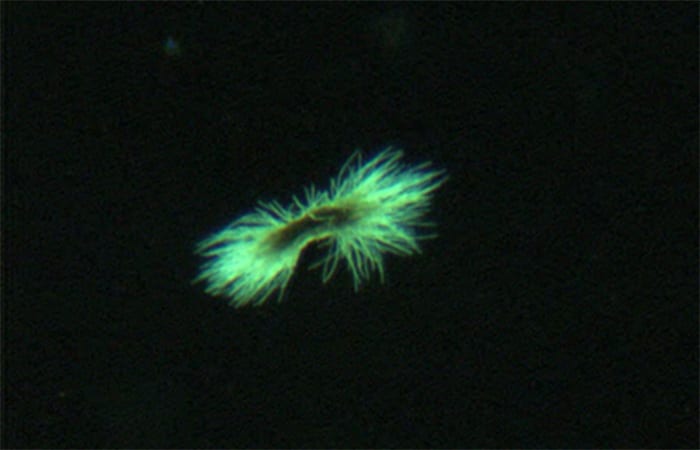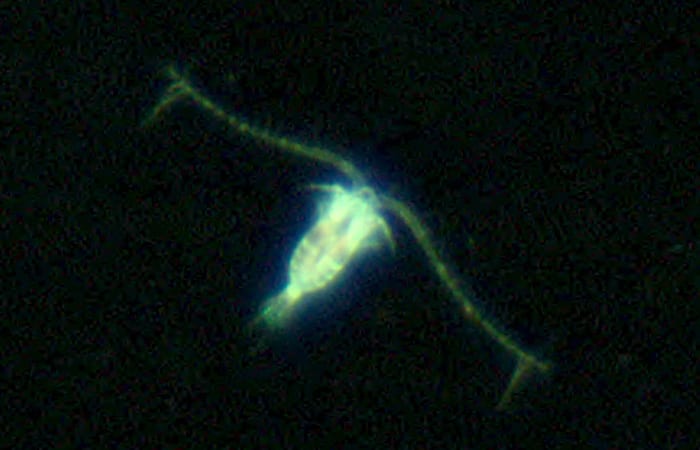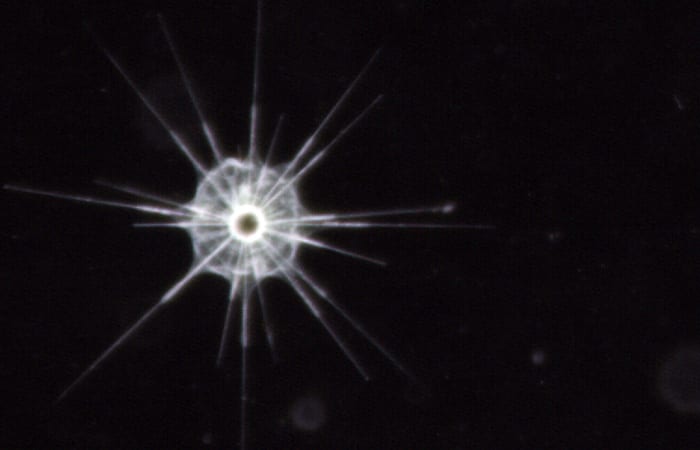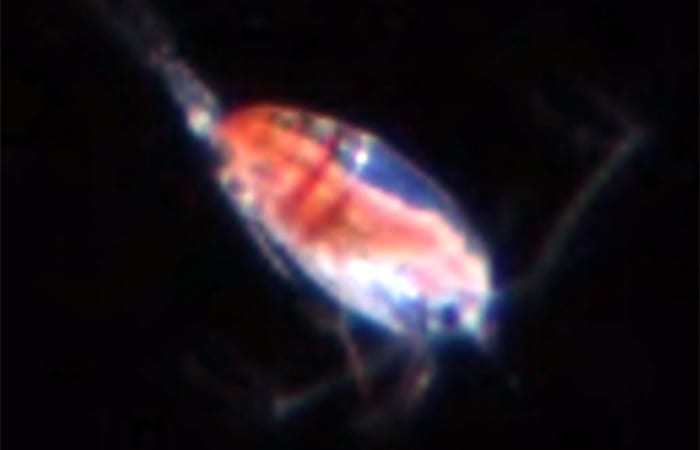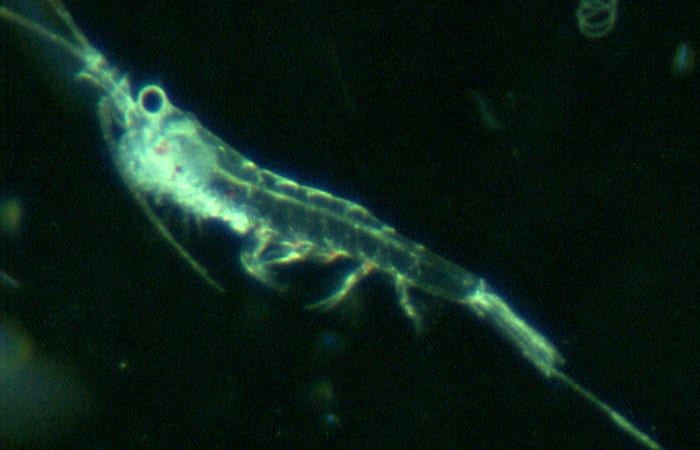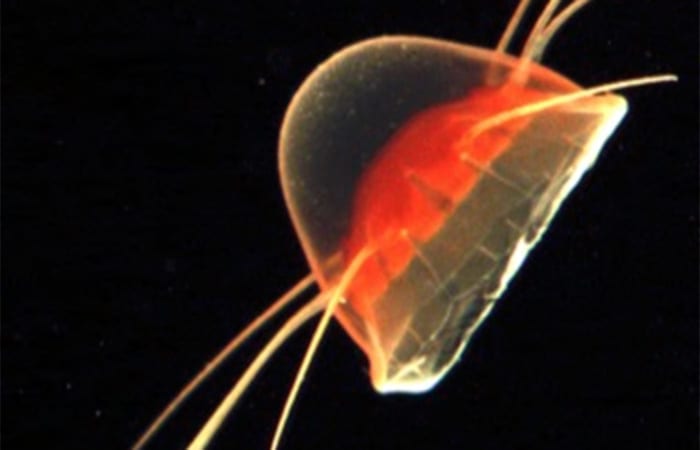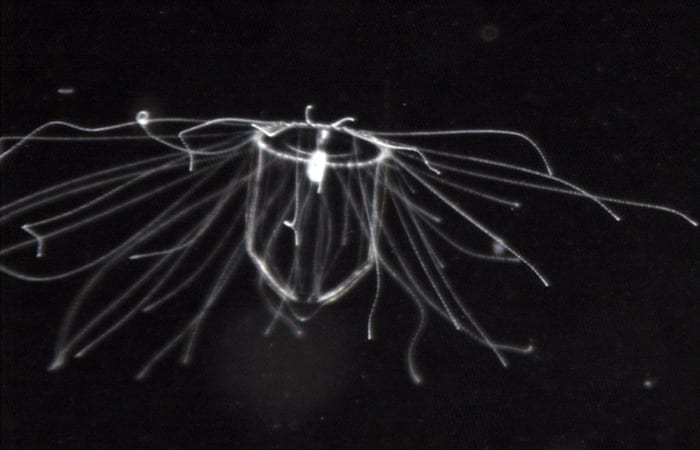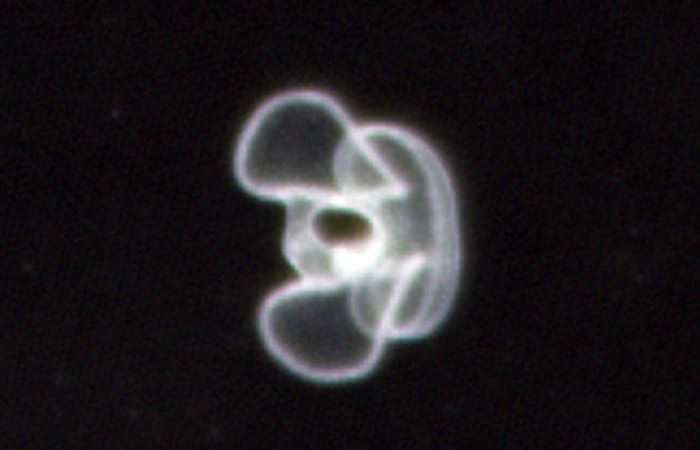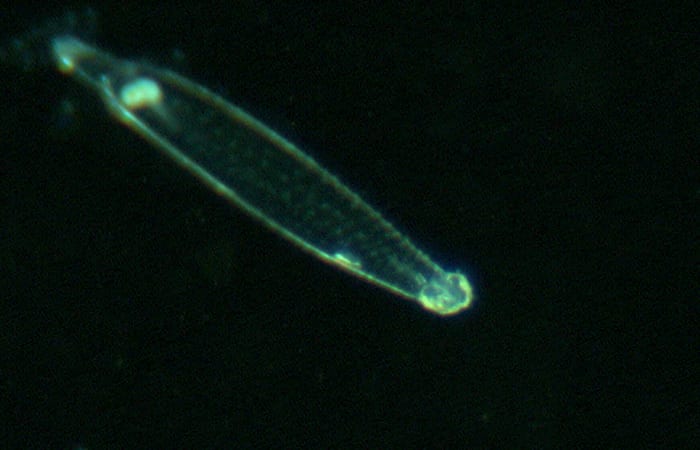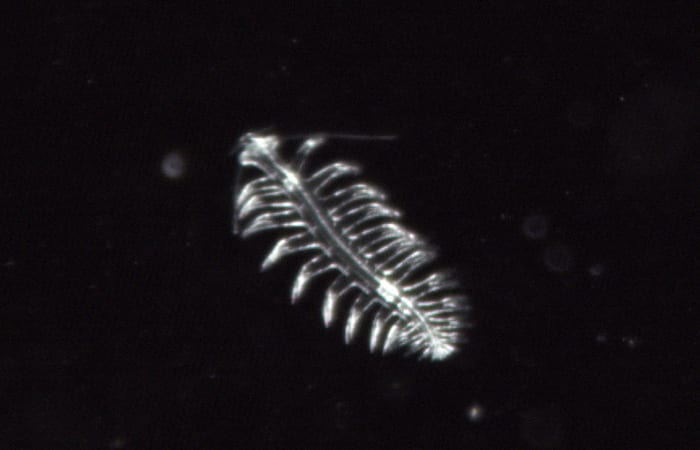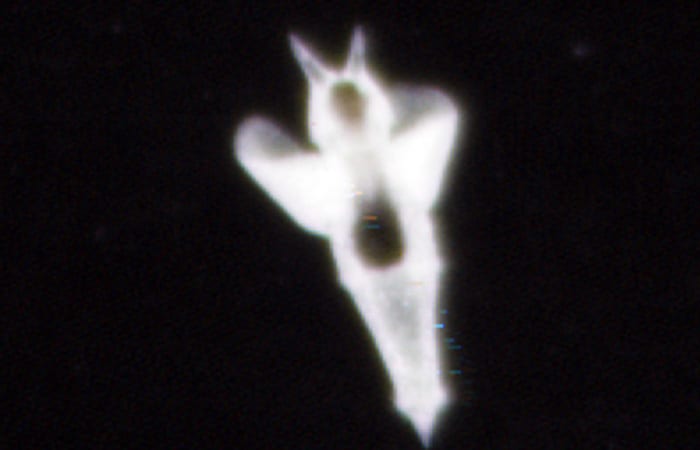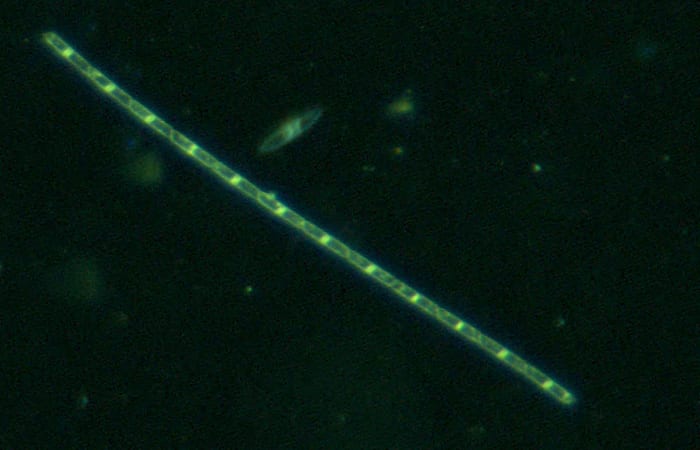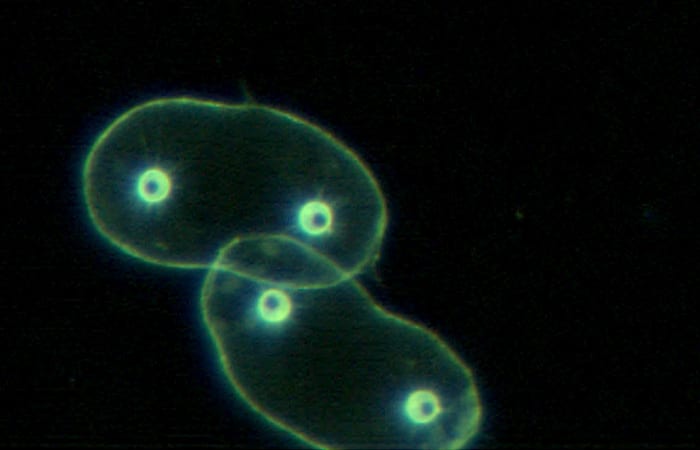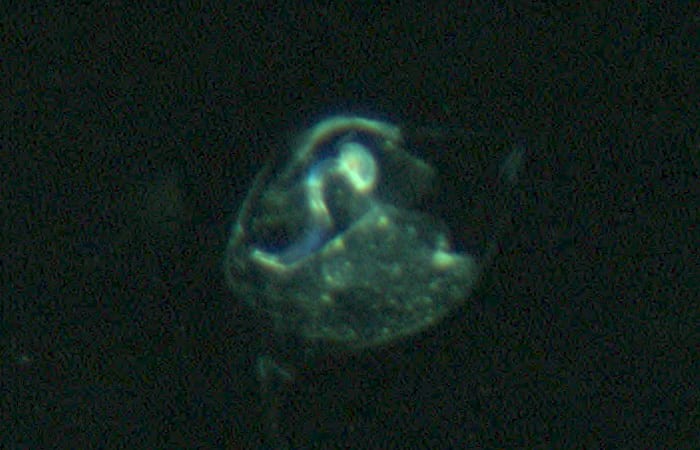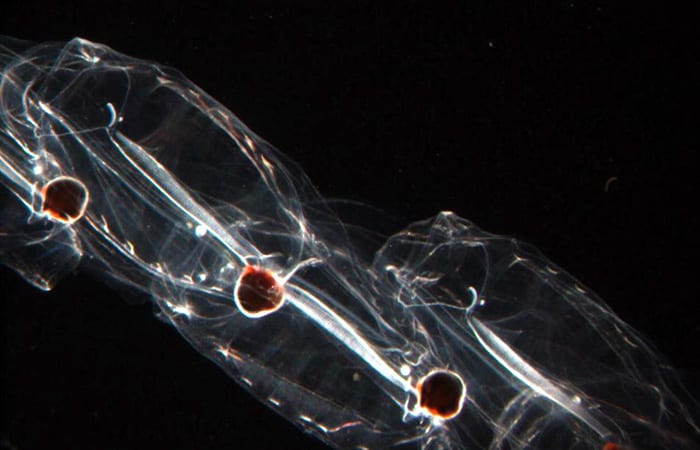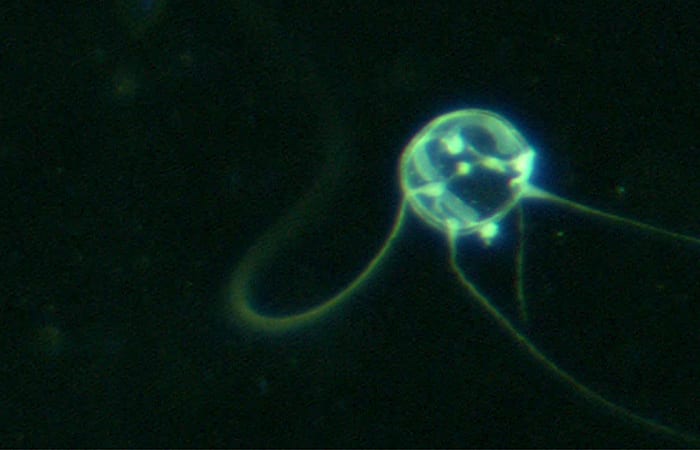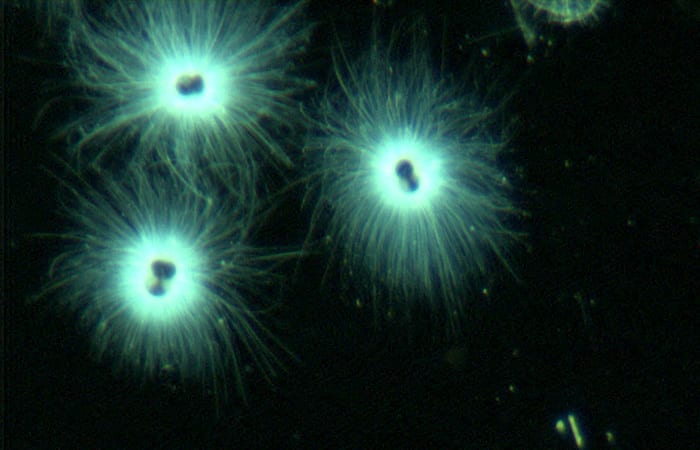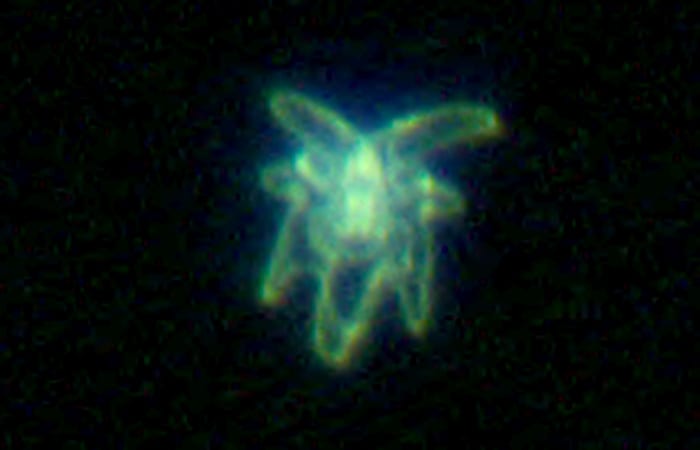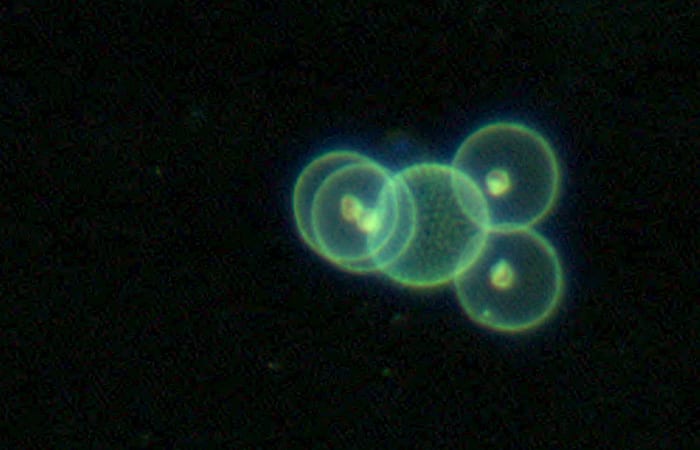- Trichodesmium are a type of colonial bacteria that form colonies with specific shapes—this one is a "bowtie." Colonies also have "puff" and "raft" (or "tuft") forms and often provide living space for other organisms from single cells to tiny plankton animals such as copepods. The VPR showed that Trichodesmium colonies are abundant across the Atlantic Ocean. They are important to the ocean ecosystem because they have the ability to convert inorganic nitrogen into organic forms that essential nutrients for other organisms. (Courtesy of Cabell Davis, Woods Hole Oceanographic Institution)
- Copepods are tiny flea-sized crustaceans that are possibly the most abundant animals on Earth. They eat algae and other tiny prey, form large aggregations, and are a critical food supply for fish larvae and other animals, including whales. (Courtesy of Cabell Davis, Woods Hole Oceanographic Institution)
- This star-shaped, single-celled organism is an acantharian. They live in the subtropical and tropical open ocean. They often contain algae that provide their nutrition, but they also consume microbes and other small plankton. They extend protoplasm along their radiating spines to catch food. (Courtesy of Cabell Davis, Woods Hole Oceanographic Institution)
- This tiny but abundant crustacean is a copepod called Pseudocalanus, photographed in the North Atlantic. Its red gut and organs are visible through its transparent covering, or exoskeleton. (VPR image courtesy of Betsy Broughton, NOAA Northeast Fisheries Science Center)
- A shrimp-like krill, about an inch long, swims upward through the frame. Krill are common ocean crustaceans that are vital in ocean food chains. Drifting in the background are single-celled and colonial algae, the krill’s food. (Courtesy of Cabell Davis, Woods Hole Oceanographic Institution)
- The Video Plankton Recorder captured this sharply detailed color image of a jellyfish called Aeginura grimaldi, a species WHOI biologist Cabell Davis calls fairly rare. Unlike nets, the VPR can record and sample fragile species such as Aeginura grimaldi without damaging them. (Image courtesy of Klas Moller, Institute for Hydrobiology and Fisheries Science, Hamburg, Germany)
- A delicate jellyfish imaged with its tentacles spread, perhaps waiting to encounter prey. The VPR’s rapid strobe-activated system photographs plankton animals without disturbing them so that they exhibit normal behavior. (Courtesy of Cabell Davis, Woods Hole Oceanographic Institution)
- Clams and other bivalves produce tiny planktonic larvae that drift until they settle down and become adults. This bivalve larva, a few hundredths of an inch long, swims using cilia—tiny hairs that beat to move the larva. (Courtesy of Cabell Davis, Woods Hole Oceanographic Institution)
- Worms are common planktonic animals. This one, called an arrow-worm or chaetognath (meaning "bristle-jaw"), is a voracious hunter that swims fast, attacks, and seizes copepods with sharp spines near its mouth. Species of arrow worm can reach four inches long but are usually smaller. (Courtesy of Cabell Davis, Woods Hole Oceanographic Institution)
- These planktonic worms, about 1 to 2 inches long, can swim well through the water using paddle-like body extensions, but this one is at rest. The VPR doesn’t produce much turbulence ahead of the instrument and uses a strobe for light, so plankton animals can be imaged undisturbed. (Courtesy of Cabell Davis, Woods Hole Oceanographic Institution)
- A ghostly sea-angel, Clione is a planktonic snail, or pteropod (meaning "wing-foot"). It is imaged in mid-stroke, with its "wings" (body extensions) flexed away from the viewer. This shell-less snail preys on other pteropods. (Courtesy of Cabell Davis, Woods Hole Oceanographic Institution)
- This VPR image of a colonial chain of diatoms, a type of algae, shows even the individual cells in the chain, itself perhaps only 1/50th of an inch long. (Courtesy of Cabell Davis, Woods Hole Oceanographic Institution)
- Two microscopc protozoans captured by strobe-flash in the VPRII's focus area. (Courtesy of Cabell Davis, Woods Hole Oceanographic Institution)
- Look closely to find the tadpole-shaped animal inside a bubble of transparent mucus. The animal is a larvacean, about ¼-inch long and soft-bodied, but it is related to fish. The "head" is actually its body, and it uses its tail to swim and to pull water through the mucus "house," which contains elaborate filtering structures made entirely of mucus. The animal makes its house with secretions, inflates it by wiggling its tail, then consumes particles of food caught on the filters. (Courtesy of Cabell Davis, Woods Hole Oceanographic Institution)
- Salps are jelly-like animals of the open ocean that often live as colonial chains. Chains of this species, Salpa aspera, swim fast, since propulsion by each inch-long animal adds together. The color VPR captured a sharp clear image of a moving salp chain. (VPR image courtesy of Betsy Broughton, NOAA Northeast Fisheries Science Center)
- A very small jellyfish, about 1/4" in diameter, with its internal structure visible. (Courtesy of Cabell Davis, Woods Hole Oceanographic Institution)
- Three delicate-looking puff balls, actually single-celled protozoans called foraminifera, are barely visible to the naked eye but were imaged by the VPRII. These are predatory cells that capture other single-celled organisms and even larger animal plankton. (Courtesy of Cabell Davis, Woods Hole Oceanographic Institution)
- A larval stage of an echinoderm, possibly a starfish. The larvae, a fraction of an inch in size, live in the plankton and pass through larval stages until they change to the adult form, when they settle and become bottom-dwellers for the rest of their lives. (Courtesy of Cabell Davis, Woods Hole Oceanographic Institution)
- Spherical colonial protozoans drift by in a group, looking like a collision of planets. (Courtesy of Cabell Davis, Woods Hole Oceanographic Institution)
SEARCH RELATED TOPICS: Phytoplankton
Image and Visual Licensing
WHOI copyright digital assets (stills and video) contained on this website can be licensed for non-commercial use upon request and approval. Please contact WHOI Digital Assets at images@whoi.edu or (508) 289-2647.
